There’s a popular idea that left-handed individuals are more creative, stemming from the notion that the brain’s right hemisphere, often linked to creativity, controls the left side of the body. This suggests that dominant left-handed people might have more developed right brain hemispheres, making them naturally inclined towards creative pursuits. While neuroscience tells us the reality is far more nuanced, the sheer number of famous left-handed guitar players lends a certain appeal to this theory.
Consider this: some of the undisputed greatest of all time in rock, blues, surf, and metal guitar are left-handed. Musical giants like Paul McCartney and David Bowie, celebrated songwriters in their own right, are also left-handed (even if Bowie famously played guitar right-handed). Perhaps left-handers are simply conditioned to be more inventive. The world isn’t always designed for them, and historically, left-handed guitar players haven’t enjoyed the same abundance of high-quality instruments. This often meant overcoming limitations with less-than-ideal gear to achieve groundbreaking sounds.
Many left-handed guitarists ingeniously adapted by learning on upside-down right-handed guitars. This forced them to forge their own unique approaches, as conventional techniques simply weren’t applicable. Whatever the underlying reasons, we celebrate the resilience and creativity of these 30 legendary left-handed guitar players, presented here in no particular order, who have undeniably left an indelible mark on music history.
1. Jimi Hendrix
 Jimi Hendrix playing a left-handed guitar with his iconic style
Jimi Hendrix playing a left-handed guitar with his iconic style
To begin with the most iconic, when the consensus greatest electric guitarist ever is left-handed, naming the top left-handed guitarist becomes straightforward. But have you ever considered how Jimi Hendrix’s left-handedness shaped his groundbreaking technique? His inverted tremolo arm placement, a consequence of playing a flipped right-handed guitar, discouraged palm muting. This happy accident contributed to his signature style, a blend of rhythm and lead playing characterized by freely ringing strings and expansive sonic textures. Furthermore, the reverse headstock on his flipped Stratocaster gave the treble strings a looser feel, which likely encouraged his incredibly expressive string bends. Even the reverse-angled bridge pickup, another quirk of his upside-down guitar, helped him temper the sometimes harsh treble frequencies often associated with Stratocasters, resulting in a uniquely balanced and powerful tone. Jimi Hendrix, a true innovator, redefined the electric guitar and remains the quintessential left-handed guitar hero.
2. Kurt Cobain
 Kurt Cobain passionately playing his left-handed Fender Jaguar
Kurt Cobain passionately playing his left-handed Fender Jaguar
Fate intervened in 1991 when a left-handed Fender Jaguar became the only suitable option Kurt Cobain could find for sale. This serendipitous purchase significantly influenced his playing and the sound of Nirvana. The Jaguar’s shorter scale length is believed to have contributed to his distinctive playing style. Visually and sonically, this offset guitar became synonymous with Nirvana’s music, perfectly embodying their departure from the dominant 1980s mainstream rock. The surging popularity of offset guitars can arguably be traced back to Kurt Cobain’s adoption of the Jaguar, just as the grunge movement itself might not have exploded without his unique and potent blend of raw power chords, melodic sensibility, and dissonant textures. Kurt Cobain, a left-handed iconoclast, and his Jaguar helped define a generation.
3. Tony Iommi
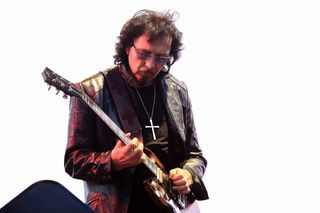 Tony Iommi, the legendary Black Sabbath guitarist, holding his signature guitar
Tony Iommi, the legendary Black Sabbath guitarist, holding his signature guitar
(Image credit: Christie Goodwin/Redferns via Getty Images)
While Tony Iommi’s left-handedness is perhaps overshadowed by the profound impact of losing his fingertips in a factory accident, his monumental catalog of riffs undeniably reinforces the idea that left-handed musicians possess a unique creative spark. Iommi’s innovative approach to guitar playing, born from necessity after his accident, inadvertently became the blueprint for heavy metal guitar. From the fundamental power chord to the ominous diminished fifth, from heavily distorted tones to the use of down-tuning for added weight and darkness, Iommi essentially wrote the metal guitar rulebook. And, decades later, he remains a towering figure, continuously demonstrating to successive generations of musicians how it’s truly done. Tony Iommi, the master of metal riffs, is a testament to left-handed creativity and resilience.
4. Albert King
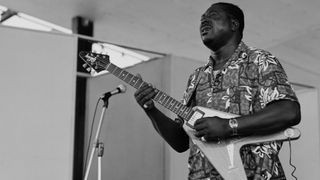 Albert King, the blues legend, playing his signature Flying V guitar
Albert King, the blues legend, playing his signature Flying V guitar
(Image credit: Getty Images)
Before Albert King, few imagined the Gibson Flying V, with its sharp angles and aggressive aesthetic, capable of such nuanced and soulful blues expression. King, a left-handed player who flipped a right-handed guitar and famously strung it upside down, developed a unique string bending technique. His reversed strings meant he had to pull down on the high E and B strings to bend them, rather than push up as on a standard right-handed guitar. This unconventional approach gave him unparalleled control and expressiveness in his bends, becoming a hallmark of his playing. Albert King’s influence reverberates through generations of blues guitarists, most notably Stevie Ray Vaughan, and he is widely considered the greatest string bender of all time. His left-handed adaptation became a cornerstone of modern blues guitar.
5. Dick Dale
Dick Dale may be instantly recognizable to many for his surf rock anthem “Misirlou,” famously featured in Pulp Fiction. That single track alone is enough to solidify his place as one of the most ferocious and influential guitar pickers to ever assault an electric guitar string. “I rip my guts out when I play,” he declared to Guitar Player in 2017, revealing the intensity and passion behind his performances. “My fingers hurt so bad when I’m pulling on the strings, but I do it because that’s where the sound comes from.” Anyone who has experienced his thunderous, reverb-drenched attack would undoubtedly attest to the truth of this statement. Dick Dale, the “King of Surf Guitar,” a left-handed pioneer, defined a genre with his raw power and innovative techniques.
6. Elliot Easton
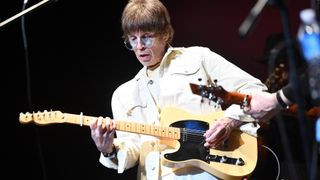 Elliot Easton of The Cars, playing his signature guitar with his distinctive style
Elliot Easton of The Cars, playing his signature guitar with his distinctive style
(Image credit: Scott Dudelson/Getty Images)
With the brilliant songwriting of Ric Ocasek at its core, The Cars seemed destined for success. However, Elliot Easton’s exceptional and distinctive lead guitar style proved to be their secret weapon, the ace up their sleeve that elevated them to iconic status. His unforgettable chord-melody guitar break in “My Best Friend’s Girl” remarkably foreshadowed Brian Setzer and the rockabilly revival that would follow. Furthermore, Easton’s impeccably tight, palm-muted power chords have become the de facto standard and a ubiquitous element in countless hit pop-rock singles ever since. Elliot Easton, a left-handed guitar innovator within the new wave movement, crafted guitar parts that were both catchy and sophisticated.
7. Elizabeth Cotten
Elizabeth Cotten penned “Freight Train” around 1904, a timeless folk classic. However, when it became a hit song in the 1950s, two English songwriters unjustly claimed credit for it. Fortunately, this egregious injustice was eventually rectified, and Cotten finally received the recognition she deserved. Her entirely self-taught guitar style, now famously known as “Cotten picking,” marked a significant development in fingerstyle guitar. Playing a right-handed guitar flipped upside down and left-handed, with reversed strings, she ingeniously plucked the bass strings with her fingers while simultaneously playing the melody lines with her thumb. Decades later, Elizabeth Cotten’s groundbreaking contributions were acknowledged when she won her first Grammy Award in 1984 at the remarkable age of 91. Elizabeth Cotten, a left-handed folk music legend, overcame adversity and innovated a unique and enduring guitar style.
8. Paul McCartney
 Paul McCartney performing "Blackbird" on acoustic guitar, showcasing his left-handed playing
Paul McCartney performing "Blackbird" on acoustic guitar, showcasing his left-handed playing
Paul McCartney’s status as one of the greatest left-handed musicians in history is undisputed. However, his substantial contributions as a guitarist are often surprisingly underrated, overshadowed by his bass playing and songwriting prowess. His distinctive approach to fingerstyle guitar, perfectly exemplified in the Beatles’ classic “Blackbird,” showcases his innovative technique of using both sides of his index finger to pluck the strings. This creates a rich and complex sound akin to conventional Travis picking. Beyond acoustic fingerstyle, McCartney’s electrifying guitar solos on tracks like “Taxman,” “Good Morning Good Morning,” and “The End” are not only memorable but also stand as worthy rivals to George Harrison’s best guitar work. Paul McCartney, a left-handed musical icon, is a multifaceted talent whose guitar skills are a vital part of his legendary artistry.
9. Al McKay
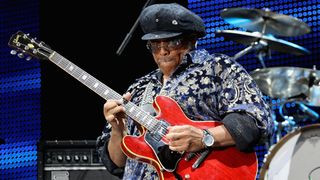 Al McKay of Earth, Wind & Fire, playing his guitar with funk and soul
Al McKay of Earth, Wind & Fire, playing his guitar with funk and soul
(Image credit: Getty Images)
Earth, Wind & Fire are primarily celebrated for their horn section, vocals, and overall groove. However, Al McKay’s crucial guitar interplay with second guitarist Johnny Graham was absolutely essential to the infectious groove that defined the band’s chart-topping hits throughout the 1970s. McKay’s masterful guitar style, a sophisticated blend of crisp single-note lines, jazzy chord voicings, and irresistibly funky triad patterns, firmly establishes him alongside Nile Rodgers as a true master of disco guitar. Al McKay, a left-handed funk guitar innovator, was a cornerstone of Earth, Wind & Fire’s signature sound, contributing rhythmic complexity and melodic sophistication.
10. Otis Rush
Chicago blues pioneer Otis Rush stands as a towering figure, a primary influence on guitar legends like Eric Clapton, Mike Bloomfield, and Peter Green. His distinctive guitar licks are some of the most emulated in the history of blues guitar. Rush also holds the distinction of recording the original version of “I Can’t Quit You Baby” a full 13 years before Led Zeppelin famously covered it. Upon Otis Rush’s passing, blues luminary Joe Bonamassa fittingly hailed him as “one of the last of the true masters,” recognizing his profound impact and enduring legacy. Otis Rush, a left-handed blues guitar innovator, shaped the sound of Chicago blues and influenced generations of musicians.
11. Babyface
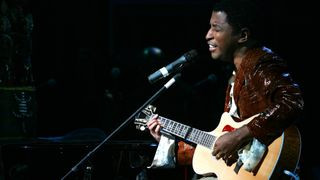 Kenneth “Babyface” Edmonds, a renowned songwriter and producer, with a guitar
Kenneth “Babyface” Edmonds, a renowned songwriter and producer, with a guitar
(Image credit: Peter Kramer/Getty Images)
Kenneth “Babyface” Edmonds is best known as one of the most exceptionally successful R&B songwriters and producers of all time. His staggering resumé includes crafting hit songs for an unparalleled roster of artists, including Whitney Houston, TLC, Chaka Khan, Aretha Franklin, and virtually every other notable name in the genre. Unsurprisingly, given his songwriting and production expertise, Babyface is also a skilled guitarist, a talent he frequently showcases in stripped-down, intimate solo performances of his numerous hits. Adding to his guitar credentials, he also produced Eric Clapton’s track “Change Your World.” Babyface, a left-handed music industry giant, is a testament to versatile talent, excelling as a songwriter, producer, and guitarist.
12. Jimmy Cliff
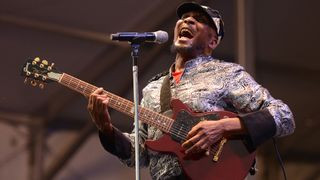 Jimmy Cliff, a reggae pioneer, holding his guitar with a smile
Jimmy Cliff, a reggae pioneer, holding his guitar with a smile
(Image credit: C Flanigan/FilmMagic)
Recipient of Jamaica’s highest honor, the Order of Merit, Jimmy Cliff stands as a genuine reggae pioneer and songwriting icon, sharing this prestigious accolade with fellow reggae titans Peter Tosh and Bob Marley. His timeless hits, including “I Can See Clearly Now” and “You Can Get It If You Really Want,” are undisputed reggae standards, embraced and covered by artists spanning diverse genres from Bruce Springsteen to New Order. Demonstrating his enduring relevance, his 2012 comeback album was notably produced by fellow left-handed musician Tim Armstrong of Rancid. Jimmy Cliff, a left-handed reggae legend, brought Jamaican music to a global audience with his songwriting and guitar playing.
13. Bobby Womack
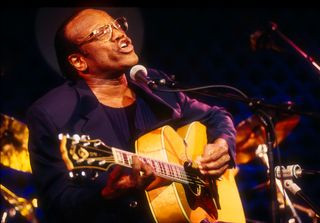 Bobby Womack, a soul music icon, performing with his guitar
Bobby Womack, a soul music icon, performing with his guitar
(Image credit: Jack Vartoogian/Getty Images)
Beginning his career as a backing guitarist for soul legend Sam Cooke provided Bobby Womack with an unparalleled apprenticeship, propelling him to stardom in his own right. His signature melodic double-stops and fluid hammer-on techniques on guitar are clearly a stylistic precursor and touchstone for Jimi Hendrix’s innovative approach. Adding to his songwriting achievements, Womack also penned The Rolling Stones’ first number one hit, “It’s All Over Now.” Bobby Womack, a left-handed soul music innovator, bridged soul, R&B, and rock with his distinctive guitar style and songwriting.
14. Omar Rodríguez-López
 Omar Rodríguez-López of At The Drive-In and The Mars Volta, playing guitar with energy
Omar Rodríguez-López of At The Drive-In and The Mars Volta, playing guitar with energy
For someone who has famously described the guitar as “this thing I hate,” Omar Rodríguez-López is remarkably proficient and innovative on the instrument. Fearlessly experimenting with effects to create sounds that often defy traditional guitar conventions, and drawing inspiration from diverse sources like jazz saxophonist Wayne Shorter and minimalist composer Steve Reich, Omar Rodríguez-López has been a pivotal figure in expanding the sonic palette of the guitar. His groundbreaking work with At the Drive-In, The Mars Volta, and his extensive solo output showcase his unique and experimental approach. Omar Rodríguez-López, a left-handed experimental guitarist, pushes boundaries and redefines the role of guitar in modern music.
15. Barbara Lynn
A comparative rarity among soul music stars, Barbara Lynn distinguished herself as a guitarist, vocalist, and prolific songwriter. Her resourceful use of a thumbpick allowed her to achieve a wide range of tonal textures and dynamics simply by switching between pick and fingers. She possessed the undeniable groove and stage presence you’d expect from someone who toured alongside music legends like James Brown, Stevie Wonder, and Gladys Knight. Despite sharing stages with such luminaries, Barbara Lynn was never relegated to a supporting role, as her captivating 1966 performance footage clearly demonstrates. Barbara Lynn, a left-handed soul guitarist and singer-songwriter, broke barriers and carved her own path in a male-dominated era.
16. Mdou Moctar
 Mdou Moctar, a Tuareg guitarist, performing his desert blues style
Mdou Moctar, a Tuareg guitarist, performing his desert blues style
Even the most seasoned and jaded observers of guitar music are consistently captivated and energized by Mdou Moctar, who brings something genuinely and refreshingly new to rock audiences. His deep roots in Tuareg and assouf (desert blues) musical traditions infuse his playing with novel rhythms and unique note choices, enriching the guitar hero vocabulary. Simultaneously, his fiery improvisational skills and stage presence firmly establish him as a worthy heir to the legacy of Jimi Hendrix. Mdou Moctar, a left-handed Tuareg guitar virtuoso, is revitalizing rock music with his unique cultural influences and virtuosic playing.
17. Eric Gales
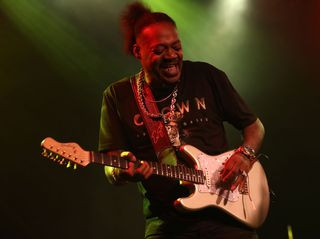 Eric Gales, a right-handed guitarist who plays left-handed style, shredding on his guitar
Eric Gales, a right-handed guitarist who plays left-handed style, shredding on his guitar
(Image credit: Harry Herd/Redferns)
Eric Gales is a fascinating exception on this list, a right-handed guitarist who plays left-handed style. He learned to play this inverted way by emulating his left-handed brother. His use of upside-down Stratocasters inevitably draws comparisons to Jimi Hendrix. However, Gales possesses the distinctive feel, tone, and exceptional chops to transcend mere comparisons and forge his own identity. His live performances, which sometimes include astonishing renditions of Beethoven’s Für Elise, demonstrate that classical music influences aren’t solely the domain of Yngwie Malmsteen. Eric Gales, a right-handed player with a left-handed approach, is a guitar phenomenon defying convention and expectations.
18. Tim Armstrong
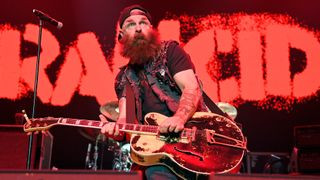 Tim Armstrong of Rancid, playing his Gretsch guitar in his punk style
Tim Armstrong of Rancid, playing his Gretsch guitar in his punk style
(Image credit: David Becker/Getty Images)
Tim Armstrong, the driving force behind Rancid, Operation Ivy, and Transplants, understands perhaps better than most the paramount importance of a great song. He has penned more than his fair share of anthems, both for his own influential bands and through collaborations with artists as diverse as P!nk and Joe Walsh. With his signature Gretsch guitar slung low, almost around his knees, Armstrong’s playing is characterized by the precise, rhythmic intensity perfectly suited for punk rock and ska. Tim Armstrong, a left-handed punk rock icon, is a master songwriter and guitarist, defining the sound of punk and ska for generations.
19. Malina Moye
Malina Moye’s path to musical stardom seemed almost preordained. Her father is a professional bassist, and her mother sang backup vocals for Tina Turner. Her trademark surf green Stratocaster has graced stages alongside blues legend Hubert Sumlin and R&B icon Chaka Khan. Notably, in 2012, she became the first and only woman to join the Experience Hendrix tour, a testament to her guitar prowess and showmanship. Her distinctive brand of blues-infused funk-rock grooves with infectious energy, perfectly exemplified by her single “K-yotic,” featuring the legendary Bootsy Collins. Malina Moye, a left-handed guitar powerhouse, is carrying the torch of funk and rock into the 21st century with her dynamic performances.
20. Doctor Isaiah Ross
Born in the Mississippi Delta in 1925, Doctor Isaiah Ross, often drawing comparisons to blues giants John Lee Hooker and Sonny Boy Williamson, possessed a unique novelty: he performed as a captivating one-man band. Despite his undeniable talent, he never achieved mainstream superstardom, perhaps because he maintained his job at General Motors even after signing a record deal. However, this unconventional choice may have also shielded him from the poverty and hardships endured by many blues pioneers. His single “Cat Squirrel” gained wider recognition when it was covered by both Cream and Jethro Tull, further solidifying his place in blues history. Doctor Isaiah Ross, a left-handed one-man band bluesman, represents the authentic Delta blues tradition.
21. Doyle Bramhall II
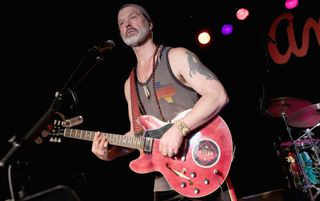 Doyle Bramhall II, a blues-rock guitarist, playing with soulful expression
Doyle Bramhall II, a blues-rock guitarist, playing with soulful expression
(Image credit: Gary Miller/Getty Images)
The blues genre might seem an unlikely breeding ground for musical dynasties, yet the Bramhall family is a notable exception. Doyle Bramhall II’s father, Doyle Sr., played drums for Freddie King and maintained a lifelong friendship with the Vaughan brothers, Stevie Ray and Jimmie. Following in his father’s footsteps, Doyle Bramhall II toured with the Fabulous Thunderbirds at the young age of 18 before joining Roger Waters’ touring band and subsequently collaborating with Eric Clapton and B.B. King on the album Riding with the King. Doyle Bramhall II, a left-handed blues-rock guitar prodigy, inherited a rich musical legacy and forged his own path as a sought-after guitarist.
22. Ernie C
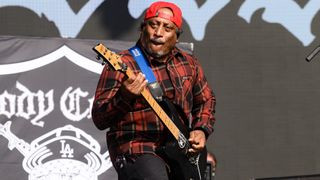 Ernie C of Body Count, playing his guitar with aggressive energy
Ernie C of Body Count, playing his guitar with aggressive energy
(Image credit: Daniel Boczarski/Getty Images)
Ernie C, the left-handed guitarist for Ice-T’s groundbreaking rap-metal crossover band Body Count, is the architect of the brutal and incendiary riffs that underpin controversial and impactful tracks like “Cop Killer,” “No Lives Matter,” and “KKK Bitch.” Beyond his guitar work with Body Count, Ernie C also played a pivotal role in the rise of Rage Against the Machine, producing their early demo. This makes him both a legend in the rap-metal genre and, arguably, ultimately responsible for the nu-metal explosion that followed. Ernie C, a left-handed rap-metal guitar innovator, fused genres and created a powerful sonic landscape for Body Count’s politically charged music.
23. Shamir
 Shamir, a unique guitarist, playing an upside-down guitar
Shamir, a unique guitarist, playing an upside-down guitar
Shamir’s unique guitar journey began when, as a young right-handed player, he unknowingly played an acoustic guitar upside down, not realizing it was unconventional due to the symmetrical body shape. He has since embraced this unconventional approach and transformed it into a strength. “Since I play upside down, I can’t use the cutaway,” Shamir explained. “I can’t do ‘guitar hero’ solos, but I think it’s made me a pretty damn good rhythm guitarist… It’s forced me to write with really intricate chords and riffs that also feel big.” Shamir, a right-handed guitarist playing upside down, demonstrates how limitations can breed creativity and unique musical styles.
24. Courtney Barnett
 Courtney Barnett, an indie rock guitarist and songwriter, performing with her guitar
Courtney Barnett, an indie rock guitarist and songwriter, performing with her guitar
Rolling Stone aptly hailed Courtney Barnett as “one of the world’s sharpest songwriters,” and her guitar playing is integral to her songwriting brilliance. Barnett has a remarkable knack for crafting guitar parts that perfectly serve her songs without ever becoming generic or predictable. Her fingerstyle approach to electric guitar playing provides her with a wide dynamic range and allows her to create unaccompanied guitar breaks that are both melodic and rhythmically compelling simultaneously. Courtney Barnett, a left-handed indie rock guitarist and songwriter, blends insightful lyrics with distinctive and engaging guitar work.
25. Hayley Kiyoko
 Hayley Kiyoko, a pop artist, playing guitar and singing
Hayley Kiyoko, a pop artist, playing guitar and singing
Hayley Kiyoko’s chart-topping pop hits, boasting streams in the hundreds of millions, often don’t prominently feature her guitar skills in the final produced versions. However, Kiyoko initially gained recognition by performing her self-penned guitar songs on social media platforms. She exemplifies how the guitar remains a potent tool for crafting compelling songs, even when those songs are later reimagined with electronic arrangements and production. Hopefully, she will revisit the guitar more prominently in her future work, as the sophisticated sliding major 7th chords in her track “Bittersweet” hint at her guitar-playing depth and potential. Hayley Kiyoko, a left-handed pop artist, started with guitar-based songwriting, demonstrating the instrument’s enduring power in contemporary music.
26. Ben Howard
 Ben Howard, an acoustic guitar innovator, performing with his unique technique
Ben Howard, an acoustic guitar innovator, performing with his unique technique
Ben Howard has rightfully earned acclaim as a modern acoustic guitar trailblazer, celebrated for his unconventional pick-and-go technique, extensive use of altered tunings, and inventive application of partial capos. On his popular track “Only Love,” for example, his guitar is tuned to an incredibly unusual A#-F-C-G-G-C, a tuning more commonly associated with extreme metal bands like Meshuggah than folk-influenced artists like John Martyn. Ben Howard, a left-handed acoustic guitar innovator, is pushing the boundaries of acoustic guitar with his experimental techniques and tunings.
27. Toronzo Cannon
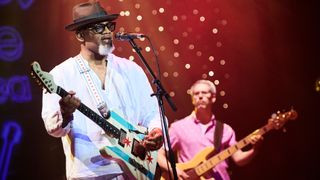 Toronzo Cannon, a modern Chicago blues guitarist, playing with intensity
Toronzo Cannon, a modern Chicago blues guitarist, playing with intensity
(Image credit: Future)
Conventional wisdom might suggest that the definitive list of Chicago blues greats is complete, with no new names to be added. However, Toronzo Cannon emphatically demonstrates that the Windy City still has invaluable lessons to teach us about electric blues guitar. Often wielding a dual-humbucker Stratocaster, Cannon is a genuine, contemporary bluesman, seamlessly blending insightful social commentary in his songwriting with deeply felt and emotionally resonant guitar playing, all topped off with a killer vibrato. Toronzo Cannon, a left-handed Chicago blues guitarist, is proving that the Chicago blues tradition is alive and evolving.
28. Maria Taylor
 Maria Taylor, an indie folk artist, performing a Tiny Desk Concert with her guitar
Maria Taylor, an indie folk artist, performing a Tiny Desk Concert with her guitar
Maria Taylor’s guitar parts possess a vulnerability and intimacy that perfectly complements her introspective songwriting. Drawing a parallel to Rolling Stones legend Keith Richards, she often utilizes only five strings on her guitar, although Taylor’s preference is to omit the high E string rather than the low E. She has collaborated with notable artists including Phoebe Bridgers, Michael Stipe of R.E.M., and Adam Duritz of Counting Crows, yet her own solo work firmly stands on its own merits, showcasing her unique artistic voice. Maria Taylor, a left-handed indie folk guitarist and songwriter, creates intimate and emotionally resonant music with her distinctive guitar style.
29. Zacky Vengeance
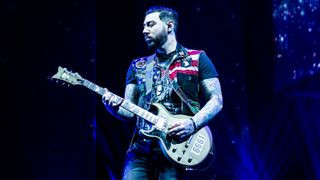 Zacky Vengeance of Avenged Sevenfold, playing guitar with metal intensity
Zacky Vengeance of Avenged Sevenfold, playing guitar with metal intensity
(Image credit: Future)
Often playing alongside Synyster Gates in Avenged Sevenfold’s guitar duo, Zacky Vengeance, while sometimes less prominently heralded, consistently matches Gates’ intensity and technical prowess in their intricate harmonized passages. He also lays down some of the most powerfully intense and driving riffs in 21st-century metal. Modern metal guitarists are expected to possess both incredible technical precision and unbridled aggression, and this left-handed guitarist effortlessly delivers both in spades. Zacky Vengeance, a left-handed metal guitarist, is a driving force behind Avenged Sevenfold’s modern metal sound, combining technicality and aggression.
30. Michael Angelo Batio
 Michael Angelo Batio, a shred guitar virtuoso, playing his double guitar
Michael Angelo Batio, a shred guitar virtuoso, playing his double guitar
While some may perceive Michael Angelo Batio’s signature double-guitar playing as somewhat of a gimmick, there is absolutely no denying his extraordinary ambidextrous guitar skills and sheer virtuosity. While footage of him playing a purely left-handed guitar may be elusive, his mind-bending wizardry on double-guitars leaves no doubt that he possesses more than enough technical ability for two guitarists combined. Michael Angelo Batio, a left-handed shred guitar icon, pushes the limits of guitar virtuosity with his incredible speed and ambidextrous techniques, even utilizing double guitars.
These 30 left-handed guitar players represent just a fraction of the incredible talent that has shaped the landscape of music. Their stories, techniques, and contributions serve as an inspiration to musicians of all orientations, proving that creativity knows no handedness. Explore their music, learn from their innovations, and perhaps, pick up a guitar yourself – whether you’re left-handed or right-handed, the world of guitar awaits.
